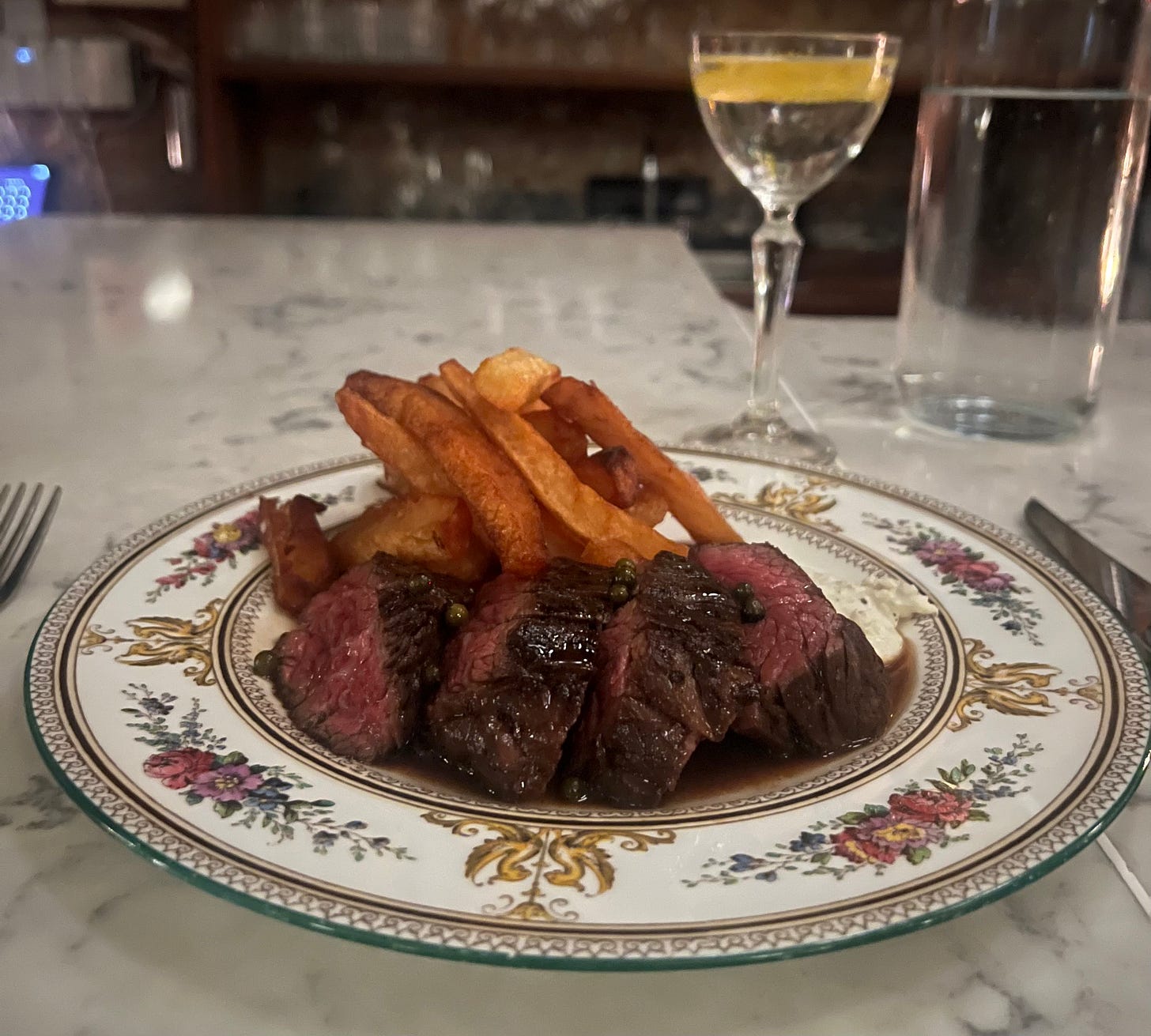Let's Order Steak Frites This Summer
A review of the sirloin au poivre at Lord's and the duck au poivre at Libertine, plus a price hike at Corner Bar and an $8 mint chip ice cream to try
A few weeks ago, when the city didn’t yet feel like a damp locker room after spin class, I treated myself to a steak dinner at Lord’s, a dark and meaty British spot by the team behind Dame. You’ll find me here often.
As well-dressed patrons filed into the room (chic clothing is a gamble at such a saucy, drippy venue), I dunked beef fat fries into a puddle of au poivre and a milky stash of horseradish cream. A bartender poured me a strong gin martini, and I sliced my way through charcoal-torched sirloin, an overall agreeable situation that led me to conclude the following:
Steak frites is an ideal summer steak dish.
New York could use more steak frites like the one Lord’s. That is: modestly portioned, au poivre, and creatively minded.
To be clear, I’m not saying that steak frites is the ideal summer dish. During these swampy times, you’re probably better off with vegan chile noodles, maybe from Dunhuang, or Xi’an. I’m also not saying that beef is the choice red meat of the summer. The leanness of duck is a better call when it’s hot out, and as luck would have it Libertine serves that fine bird in the style of au poivre — more on that below.
But just as so many folks seek out hot noodle soups in July, sometimes you simply want that steak (heck, you don’t see ramen spots or chophouses shutting down for the season). The key is to limit the GI damage with a smaller portion of meat. The key is to order steak frites.
In defense of a smaller summertime steak…
The nice thing about seeing steak frites on a menu is that it’s almost always code for a classic, not-too-fancy steak “for one.”
Steak frites, or bistro steaks, are smaller than their Balrog-sized counterparts at proper chophouses. A solo diner should be able to finish one without overburdening their stomach, regardless of the season. There should be no leftovers. It’s a one-dish meal, an excuse to skip the expensive starters and go straight to the main event.
Though ideally your appetizer will be the first of two martinis.
A bistro steak also eliminates the need to tack on $12 for sides, because that side is already included in the form of a lightly dressed salad or fries.
No, you won’t find the same dry-aged complexity as with a heftier steakhouse cut, nor will you encounter the same gorgeous marbling of Japanese wagyu. But that’s not why you’re here, at your local tavern or brasserie. You order steak frites for a cut of meat that you don’t have to think about too much. This is what you get when you crave something salty, juicy, and bloody — that you can keep eating while chatting with your friend about a tough breakup or a long day at work.
Indeed, the reasonable portions and straightforward flavors of a bistro cut are among its greatest attributes, especially in a world of stratospheric beef prices. Or to put it more bluntly: these cuts aren’t just smaller; they’re also more affordable, if that’s the right term for something that still costs $40 or more.
What makes the Lord’s sirloin stand out from the pack is that it’s particularly restrained in size, at just seven ounces. That’s lighter than the eight-ounce portion at Skirt Steak in Midtown, or the 12-ounce rump cut at Hawksmoor ($36; fries are extra).
Making matters even more interesting is that Lord’s belongs to a small but growing class of casual-ish spots, along with Corner Bar and Libertine, doing really cool (but not too esoteric) things with au poivre.
Chef Ed Szymanski and owner Patricia Howard penned nearly 300 words when I asked them to describe the fastidious process of making the sauce. In short, they rely on a few fun tweaks like adding dry-aged beef trim for concentrated flavor, and melting in pork trotters and calves’ feet to build a gelatinous, meaty texture — very different than more luscious au poivres with cream (like at Pastis).
The sirloin (technically a flap cut) packs subtle smoke aromas thanks to the charcoal grilling, but the sauce takes things to another level, enrobing the lean meat with a powerful beefiness and stickiness. And then you dunk a musky beef fat fry into cool horseradish crème to cleanse the palate. And you let the bright sting of peppercorns jolt you with warmth inside the air conditioned room.
It’s a steak frites packed with so many delicious elements that one could theoretically omit the actual steak and be none the worse off. It’s all so distinctive that Szymanski has effectively transformed a beloved yet predictable dish into something as creative as you’d expect from a small plates place or a tasting menu spot. It costs $42, or $54 after tax and tip.





